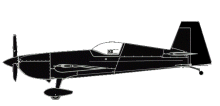
ASN Wikibase Occurrence # 213805
This information is added by users of ASN. Neither ASN nor the Flight Safety Foundation are responsible for the completeness or correctness of this information.
If you feel this information is incomplete or incorrect, you can submit corrected information.
| Date: | Sunday 29 July 2018 |
| Time: | 14:35 |
| Type: |  Extra EA-300LC |
| Owner/operator: | Private |
| Registration: | N32WR |
| MSN: | LC033 |
| Year of manufacture: | 2014 |
| Total airframe hrs: | 217 hours |
| Fatalities: | Fatalities: 0 / Occupants: 2 |
| Aircraft damage: | Substantial |
| Category: | Accident |
| Location: | North Fox Island Airport (6Y3), North Fox Island, MI -
 United States of America United States of America
|
| Phase: | Landing |
| Nature: | Private |
| Departure airport: | Appleton, WI (ATW) |
| North Fox Island, MI (6Y3) | |
| Investigating agency: | NTSB |
| Confidence Rating: |
An airline transport pilot in an aerobatic low-wing airplane, an Extra 300, with a passenger on board was landing while an airline transport pilot in a high-wing airplane, a Cessna 172, near maximum weight with two passengers on board was conducting a short/soft-field takeoff from an nontowered, island-based runway surrounded by tall trees.
The Extra pilot and passenger reported that the pilot’s landing intention was communicated on the common traffic advisory frequency (CTAF) with no replies. They saw an airplane at the opposite end of the airstrip, and the pilot decided to land. The Cessna pilot reported that he monitored the CTAF and then taxied down the center of the runway; he heard a radio call on the frequency from an airport on a nearby island. The Cessna pilot made his departure radio call on the CTAF in the blind and conducted a rolling departure with as much runway ahead as possible; he did not hear or see any other airplanes. The Cessna lifted off about 5 to 7 ft above ground level and accelerated to best angle of climb speed plus 10 knots. The Extra pilot indicated that he did not see any aircraft while he was on final approach to landing until his airplane was about 20-30 ft above the landing surface just before the threshold when he saw a bright object out the right side just in front of the wing. The Extra and the Cessna then collided.
The CTAF frequency at the accident airport is not recorded. However, a witness monitoring another CTAF frequency on a nearby island overheard the pilot of an airplane calling intention to land and remarked to a customer that the call was on the wrong frequency. It is likely that the Extra pilot was transmitting on the CTAF frequency for the airport on a nearby island; the Cessna pilot likely heard this transmission but attributed it to a pilot landing at the other airport.
The airport leaseholder’s website contained a link to pilot information, which included a safety briefing for the airport. The briefing recommended that the airport’s CTAF, as well as another local airport’s CTAF, be monitored. In addition, the briefing recommended that arriving aircraft fly over the airfield and scan for aircraft on the ground using a left traffic pattern. The briefing advised that the airport is in the Unimproved Airport Category and that pilots “land at your own risk.”
The Extra pilot’s use of an incorrect CTAF precluded him from hearing the Cessna pilot’s transmission of his intent to depart. In addition, trees surrounding the runway precluded the Extra pilot from seeing the Cessna’s departure until it was too late to take evasive action.
Probable Cause: The Extra pilot’s failure to see and avoid the Cessna, which resulted in an in-flight collision. Contributing to the accident was the failure of the Extra pilot to tune his radio to the correct frequency, which resulted in no common traffic advisories being heard or recognized as relevant by either pilot.
Accident investigation:
 |
|
Sources:
NTSB
https://flightaware.com/photos/view/1215245-59af1fc4d0f4583b818ac802a07c28e4b832dbd5/aircrafttype/E300/size/fullsize
Location
Revision history:
| Date/time | Contributor | Updates |
|---|---|---|
| 30-Jul-2018 03:31 | Geno | Added |
| 31-Jul-2018 18:29 | Captain Adam | Updated [Aircraft type, Registration, Cn, Operator, Nature, Source, Damage] |
| 01-Aug-2018 00:09 | Geno | Updated [Total occupants, Source] |
| 06-Aug-2018 18:52 | Anon. | Updated [Total occupants] |
| 27-Nov-2019 07:15 | ASN Update Bot | Updated [Time, Operator, Departure airport, Destination airport, Source, Narrative, Accident report, ] |
Corrections or additions? ... Edit this accident description
The Aviation Safety Network is an exclusive service provided by:


 ©2024 Flight Safety Foundation
©2024 Flight Safety Foundation